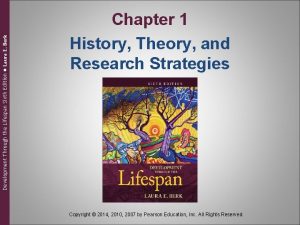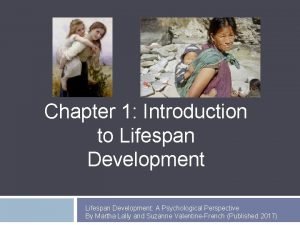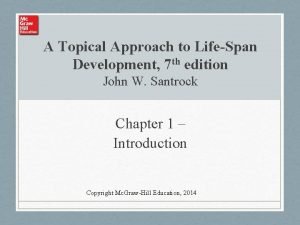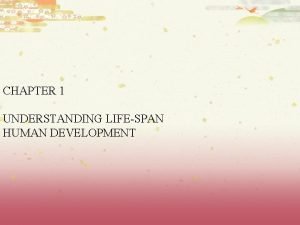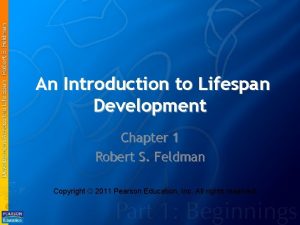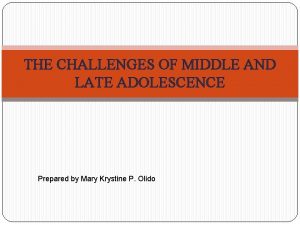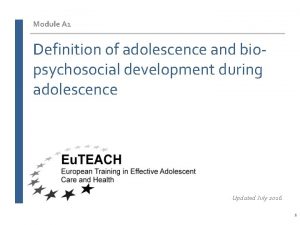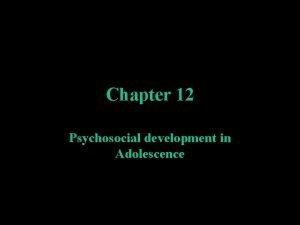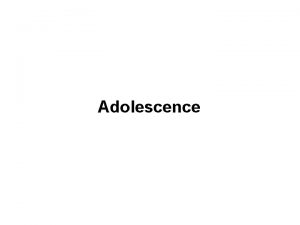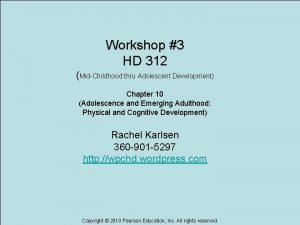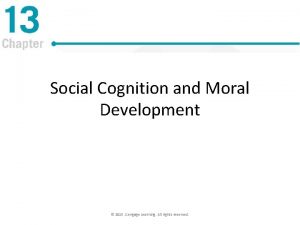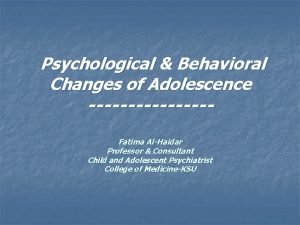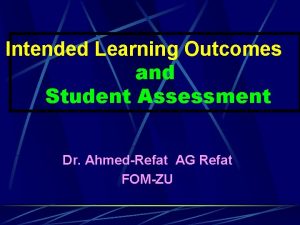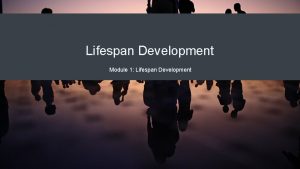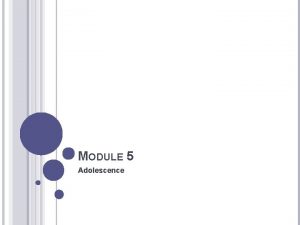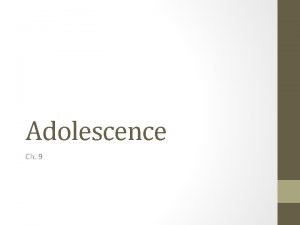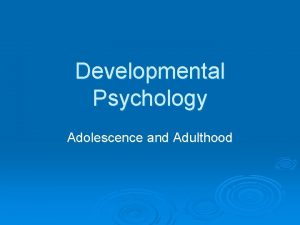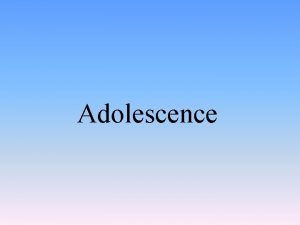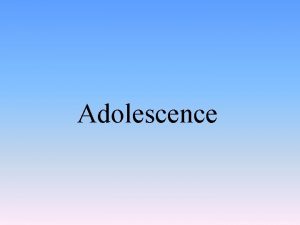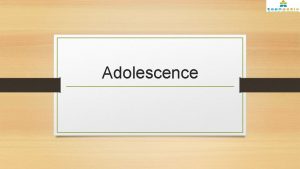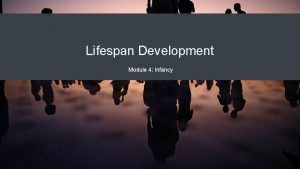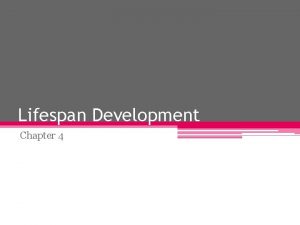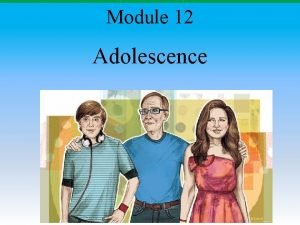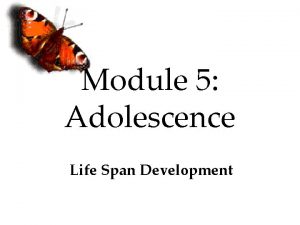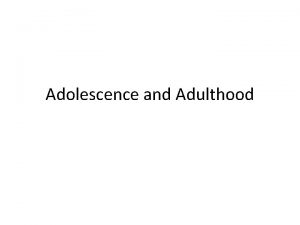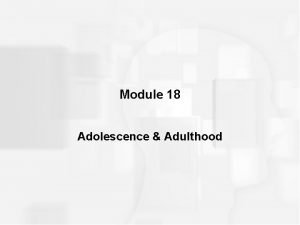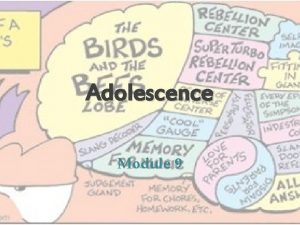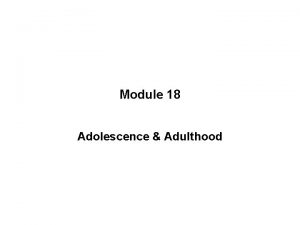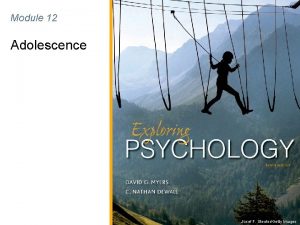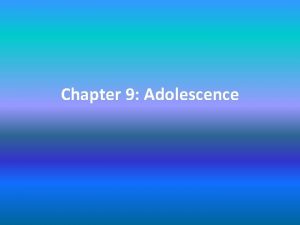Lifespan Development Module 7 Adolescence Module Learning Outcomes
































- Slides: 32

Lifespan Development Module 7: Adolescence

Module Learning Outcomes Describe the physical, cognitive, emotional, and social changes that occur during adolescence • 7. 1 describe the physical changes that occur during puberty and adolescence • 7. 2 Describe changes in cognitive development and moral reasoning during adolescence • 7. 3 describe adolescent identity development and social influences on development

Physical Changes of Adolescence

Learning Outcomes: Physical Changes of Adolescence • 7. 1 Describe the physical changes that occur during puberty and adolescence • 7. 1. 1: Describe pubertal changes in body size, proportions, and sexual maturity • 7. 1. 2: Explain social and emotional attitudes and reactions toward puberty, including sex differences • 7. 1. 3: Describe brain development during adolescence • 7. 1. 4: Describe health concerns during adolescence • 7. 1. 5: Discuss concerns associated with eating disorders

Physical Development- Puberty • Hormonal changes • Phase 1 of puberty: Adrenarche • • Release of adrenal androgens • Skeletal growth As adolescents develop, physical abilities increase • Begins around age 6 -8 Phase 2: Gonadarche- sex hormones (estrogen, testosterone) • Menarche- first menstrual period (~age 12 -13) • Spermarche- first ejaculation (~age 13 -14) • Sexual maturation • Primary sex characteristics • • Relate directly to reproductive capabilities Secondary sex characteristics • Do not directly relate to reproductive capabilities

Physical Growth: The Growth Spurt • Growth spurts: Girls (age ~8 -13) Boys (age ~10 -16) • Increased height weight, reach adult proportions • Early developers & reactions • Girls: often get unwanted attention, teasing • • Increased risk for depression, eating disorders, early sexual activity, substance abuse Boys: risks and benefits • May be more athletic, taller • Increased risk for substance abuse, early sexual activity • Late developers/ “late bloomers” • Boys: risk of bullying, depression, parental conflict • Girls: risk of teasing, bullying • Overall, more positive outcomes for late-maturing girls than early-maturing girls Figure 1. Girls often experience a growth spurt before boys of the same age. These girls appear comfortable and confident, a sign of healthy development.

Brain Development During Adolescence • Prefrontal cortex- decision-making, higher level cognition • Myelination: increases information processing speed • Synaptic pruning: strengthens strongest neural connections • Limbic system- develops before prefrontal cortex • Responsible for emotional processing, rewards & punishments • Pubertal hormones target the amygdala • Dopamine: the “feel good” chemical- production is high • • Involved in pleasure-seeking, risk-taking behaviors Serotonin: calming chemical, balances dopamine, extreme behaviors • Sleep • Melatonin levels increase later in the night making “night owls” • • vs. “early risers” Teens need 9 -10 hrs of sleep Deficit of sleep increases impulsivity, negative emotions The brain reaches its largest size in the early teen years, but continues to mature well into the 20 s.

Health Concerns During Adolescence • Negative body image, body dissatisfaction • Associated w/ poor nutrition, atypical eating patterns • Eating disorders • Muscle dysmorphia- obsession with muscle development • Bulimia nervosa- binge/purge cycles, often normal weight • Anorexia nervosa- distorted body image, underweight, low caloric intake • Binge-eating disorder- overeating sprees, often associated w/ anxiety, depression, obesity • Health consequences of eating disorders • Anorexia: most fatal mental disorder, suicide is more common • Binge eating: Type II diabetes, obesity, high cholesterol, heart disease, high blood pressure • Treatment of eating disorders • Cognitive Behavioral Therapy (CBT), medication, counseling • Parental involvement, monitoring

Sexual Development • Sexual interactions • • • Body image ideals, media portrayals Masturbation, sexual fascination Text messaging, email, phone calls may evoke sexual feelings Sexually Transmitted Infection (STI) risk for sexually active teens Sex education • It’s about more than preventing teen pregnancy • Freud & sexual development • Genital stage of psychosexual development • Ego, superego more developed • Secondary-process thinking/desires • Friendships, intimate relationships, adult & family responsibilities

Practice Question 1 Which part of the adolescent brain is the last to fully develop? A. B. C. D. Prefrontal cortex Limbic system Dopamine circuit Hippocampus

Practice Question 2 According to Freud, what stage of psychosexual development is Anna, a teenager in? A. B. C. D. Phallic stage Anal stage Oral stage Genital stage

Cognitive Development During Adolescence

Learning Outcomes: Cognitive Development During Adolescence • 7. 2 Describe changes in cognitive development and moral reasoning during adolescence • • 7. 2. 1 Explain Piaget's theory on formal operational thought 7. 2. 2 Describe cognitive abilities and changes during adolescence 7. 2. 3 Describe the role of secondary education in adolescent development 7. 2. 4 Describe moral development during adolescence

Cognitive Development during Adolescence, continued • Perspectives: constructivist (Piagetian), & • information-processing Major improvements in thinking abilities: • Attention • Selective attention, divided attention • Memory • Working memory, long-term memory improve • Processing speed • Increases & levels off in adolescence • Organization • Strategies & processes, mnemonics, etc. • Metacognition • Thinking about thinking, planning ahead

Perspectives on Adolescent Cognition • Piaget- constructivism: formal operational thought • Quantitative, stage-approach • Hypothetical thinking: What if? • Based on deductive reasoning Abstract thinking: reality is not black & white Metacognition: thinking about thinking • • Adolescents engage in hypothetical and • Elkind: adolescent egocentrism, based on Piaget abstract thinking. • Imaginary audience: belief others are watching and judging one’s behaviors • Personal fable: belief in one’s unique qualities, part of imaginary audience • construction Invincibility fable: Probabilistic consequences don’t apply to one’s self

Perspectives on Adolescent Cognition, cont. • Information Processing perspective • Dual-process model • Intuitive & analytical thought follow different pathways • Intuitive: automatic, unconscious, fast • Experiential, emotional Analytic: deliberate, conscious, rational • Teenage thinking is characterized by the ability • Risk-taking • Behavioral decision-making: weigh rewards & consequences to reason logically and solve hypothetical problems such as how to design, plan, and of actions Attuned to social rewards vs. long-term consequences • • Relativistic thinking: questioning absolute truth • Religious doubt, rules born of one’s own principles, common • sense Cultural relativism build a structure. (credit: U. S. Army RDECOM)

School in Adolescence- Secondary Education • Middle School • Puberty • • • Declining age of puberty necessitates transitional education • Transition to early adolescence Schedule changes, social changes, egocentrism • Academic schedules, extracurricular involvement, social expectations • Peer acceptance is highly important Bullying, cyberbullying • Technology creates psychological distance • High School • • Practice analytical thinking, prepare for adult life Spend more time with peers than with family Degree attainment predicts later success Academic achievement as indicator of adjustment

Moral Reasoning During Adolescence • • • Independence increases Kohlberg: postconventional morality • Morals determined by self-chosen ethics, principles Influences • Home, media, school • Peers, close friends have profound influence Figure 1. Adolescents’ moral development gets put to the test in real life situations, often along with peer pressure to behave or not behave in particular ways.

Practice Question 3 Given the following examples, which of these students is actively engaging in metacognition? A. Rhetta, who is practicing study skills using techniques like mnemonic devices. B. Lyanna, who realizes the problem-solving technique she is using will lead to undesirable consequences, and changes her plan of action. C. Johanna, who multi-tasks while studying, listening to music and switching between homework subjects to prevent fatigue. D. Nyam, whose typing speed has improved to the point where he can transcribe whole sentences without needing to pause his work.

Class Activity: Adolescent egocentrism? • • Find a diary or journal entry (or any writing assignment) from middle or high school, re-read it. If unable to find your own original work, access an open source document or internet post written by an adolescent. Identify any examples of the adolescent personal fable, beliefs of invincibility, and the imaginary audience phenomenon. Describe what cognitive processes were likely taking place at the time the entry was written. Discuss your findings with classmates.

Social Development During Adolescence

Learning Outcomes: Social Development During Adolescence • 7. 3 describe adolescent identity development and social influences on development • • • 7. 3. 1 Describe changes in self-concept and identity development during adolescence 7. 3. 2 Explain Marcia's four identity statuses 7. 3. 3 Examine changes in family relationships during adolescence 7. 3. 4 Describe adolescent friendships and dating relationships as they apply to development 7. 3. 5 Explain the role that aggression, anxiety, and depression play in adolescent development

Psychosocial Development • Identity Development • Identity is developing, rather than forming • Self-concept • Self-awareness, based on beliefs, values, opinions, thoughts • Possible & ideal selves • Self-esteem • No evidence of severe adolescent drop in SE • “Barometric” self-esteem fluctuates • Based on self-concept, relationships • Erikson: Identity vs. Role Confusion • “Who am I? ” & “Who do I want to be? ” • Identity achievement= crisis resolved Figure 1. Adolescents simultaneously struggle to fit in with their peers and to form their own unique identities.

Identity Development, cont. I • Marcia’s identity statuses • Exploration, commitment vary • Other dimensions of identity • Religious identity • • • Family influence, questioning Political identity • Social issues, youth tend to more liberal views than parents Vocational identity • Part-time teen jobs don’t prepare for full-time future careers Ethnic identity • Phinney- stages: Unexplored, search, achievement Gender identity • Self-perception on a spectrum James Marcia’s 4 identity statuses:

Identity development, cont. II • Gender identity • Sex vs. gender • Sex: biological • Gender: social construct • Cisgender: identifies with birth sex as gender • Transgender: gender identity differs from birth sex • Genderqueer: gender identity does not conform to conventional gender distinctions, non-binary • Gender expression • Largely based on social expectations • “Masculine” and “Feminine” dimensions • Interactions, clothing, behaviors • Sexual orientation • Separate construct from gender identity • Denotes emotional/ sexual attraction Figure 2. This identity spectrum shows the fluidity between sex, gender identity, gender expression, and sexual orientation.

Understanding Social Development during Adolescence • Social changes • Shift in influence: from parents to peers • Parent- child relationships change • More autonomy, less control • Peer relationships • • • Homophily: “birds of a feather flock together” Peer pressure can be positive Peer relationships take on greater significance in Deviant peer contagion: negative peer pressure adolescence Crowds: perceived commonalities, reputations Cliques: groups w/ frequent interaction Romantic relationships- become more important, emotional development • LGBT+ individuals- coming out to friends & family • Experience varying levels of support

Aggression and antisocial behavior • Patterson: • Early starters vs. Late starters • Early starters more likely to persist long-term • • May be personal factors Late starters: limited duration- adolescence only • lack of parental monitoring becomes salient • Deviance ends when more alternative options arise • Moffitt: • Life-course persistent vs. adolescent-limited • Life-course persistent typically start earlier • Adolescent-limited- result of “maturity gap” Early antisocial behavior leads to befriending others who also engage in antisocial behavior, which only perpetuates the downward cycle of aggression and wrongful acts.

Anxiety & Depression • Anxiety • Most common: specific phobias • Major depression • Genetics, early childhood experiences • ~15% or 1 in 5 girls, 1 in 10 boys experience major depression • Increased risk for suicide • Gender differences • Biological & cultural differences • Gene x environment interactions • Suicide • Suicidal ideation: distressing thoughts about killing one’s self • Parasuicide, or attempted/failed suicide • Talk about it!

Practice Question 4 Why is adolescence a crucial time for monitoring mental health? A. B. C. D. Anxiety and depression may lead to increased risk of suicide Suicide is one of the leading causes of teen deaths Many mental health concerns arise during adolescence, as the brain matures All of the above

Class Activity: Identity statuses • • Separate into small groups and discuss which of Marcia’s identity statuses each group member identifies with, and why Discuss any cultural, familial, and social influences on their perceived status Compare and contrast Marcia’s identity statuses to Erikson’s “Identity versus role confusion” crisis. Present each group’s main theories and influences to the class.

Quick Review • What bodily changes occur in puberty regarding body proportions, body size, and sexual maturity? • What attitudes and emotional reactions are commonly associated with, puberty, and how do they differ by sex? • In what ways to adolescents’ brains develop? • What are some primary health concerns during adolescence? • What health concerns are associated with eating disorders? • How does Piaget's theory on formal operational thought apply to adolescence?

Quick Review - continued • • • How do cognitive abilities and cognitions change during adolescence? What role does secondary education play in adolescent development? How do adolescents develop morally? How does self-concept change and identity develop during adolescence? What are Marcia's four identity statuses, and how do they apply to adolescents? • In what ways do family relationships change during adolescence? • How do adolescent friendships and dating relationships apply to development? • What role do aggression, anxiety, and depression play in adolescent development?
 Development through the lifespan 6th edition
Development through the lifespan 6th edition Lifespan development a psychological perspective
Lifespan development a psychological perspective Openstax
Openstax Introduction to lifespan development
Introduction to lifespan development A topical approach to lifespan development
A topical approach to lifespan development Ul guidance counselling
Ul guidance counselling Lifespan development third edition
Lifespan development third edition Lifespan development third edition
Lifespan development third edition Exploring lifespan development chapter 1
Exploring lifespan development chapter 1 Sociocultural graded influences
Sociocultural graded influences Challenges of middle and late adolescence
Challenges of middle and late adolescence Brain development adolescence
Brain development adolescence Moral development in adolescence
Moral development in adolescence Late adolescence
Late adolescence Psychosocial development in adolescence
Psychosocial development in adolescence Physical development in adolescence
Physical development in adolescence Moral development in adolescence
Moral development in adolescence Moral development in adolescence
Moral development in adolescence Emotional development in adolescence
Emotional development in adolescence Learning outcome example
Learning outcome example Learning outcomes of water cycle
Learning outcomes of water cycle Learning objectives of notice writing
Learning objectives of notice writing Objectives of swot analysis
Objectives of swot analysis Objective of rhymes
Objective of rhymes Planning goals and learning outcomes
Planning goals and learning outcomes Photolysis of water
Photolysis of water Learning outcomes of nutrition in plants
Learning outcomes of nutrition in plants What is ncbts?
What is ncbts? Learning objectives of linear equations in one variable
Learning objectives of linear equations in one variable A machine that converts mechanical energy into electricity
A machine that converts mechanical energy into electricity Direct and indirect speech objectives
Direct and indirect speech objectives Purpose of learning outcomes
Purpose of learning outcomes Learning outcomes of input and output devices
Learning outcomes of input and output devices
